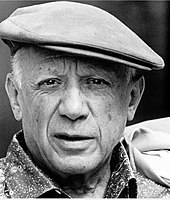
Introduction: Picasso’s Ever-Evolving Artistry
Pablo Picasso (1881-1973) was one of the most influential and innovative artists in history. Over the course of his eight-decade career, he revolutionized art multiple times, pioneering movements such as Cubism, Neoclassicism, Surrealism, and Abstract Expressionism.
His paintings evolved dramatically over the years, reflecting:
✅ Radical stylistic shifts across different periods
✅ Deep engagement with political and social issues
✅ A relentless drive to break artistic conventions
This page serves as a comprehensive guide to Picasso’s artistic journey, highlighting each major phase of his career and linking to dedicated galleries showcasing his high-resolution paintings from different decades.
Picasso’s Artistic Eras: A Timeline of His Evolution
1. The Early Years (1901-1909) – Blue and Rose Periods
🔹 Blue Period (1901-1904) – Melancholic, monochromatic paintings reflecting themes of poverty, despair, and isolation.
🔹 Rose Period (1904-1906) – A shift to warmer tones and playful themes, featuring circus performers and harlequins.
🔹 Proto-Cubist Works (1907-1909) – The emergence of geometric abstraction, leading to Cubism.
🔗 Explore Picasso’s Early Paintings (1901-1909)
2. The Rise of Cubism (1910-1919) – Analytical and Synthetic Phases
🟢 Analytical Cubism (1910-1912) – A groundbreaking approach that deconstructed objects into geometric fragments.
🟢 Synthetic Cubism (1912-1914) – The introduction of collage elements, bold colors, and mixed media techniques.
🟢 Post-War Transition (1915-1919) – A gradual shift towards Neoclassicism, influenced by World War I.
🔗 Explore Picasso’s Cubist Masterpieces (1910-1919)
3. The Classical and Surrealist Periods (1920-1929)
🟠 Neoclassical Phase (1920-1924) – A return to traditional, Renaissance-inspired figures, exploring grandeur and symmetry.
🟠 Surrealist Experimentation (1925-1929) – The integration of dreamlike distortions, elongated forms, and subconscious themes.
🔗 Explore Picasso’s Neoclassical and Surrealist Works (1920-1929)
4. Political Art and War-Time Expression (1930-1939)
🔴 Surrealist Influences (1930-1935) – A fusion of Cubist abstraction and psychological intensity.
🔴 Spanish Civil War & Anti-Fascist Art (1936-1939) – The creation of Guernica (1937), Picasso’s most powerful anti-war statement.
🔗 Explore Picasso’s Paintings of the 1930s
5. The Post-War Years and Political Commitment (1940-1949)
🟣 Wartime Resistance (1940-1945) – Paintings reflecting suffering, oppression, and political defiance.
🟣 Communist Affiliation & Peace Symbolism (1945-1949) – The famous “Dove of Peace” and works advocating for global unity.
🔗 Explore Picasso’s Post-War Paintings (1940-1949)
6. Experimental Reinterpretations & Bold Gestural Art (1950-1959)
🔵 Political Works (1950-1955) – Anti-war and Communist-inspired paintings.
🔵 Reinterpretations of the Old Masters (1954-1959) – Modernist versions of Velázquez, Delacroix, and Manet.
🔗 Explore Picasso’s Paintings of the 1950s
7. Late-Career Freedom & Abstract Expressionism (1960-1969)
🟢 Gestural, Abstract Forms (1960-1965) – Loose, energetic brushstrokes, showing influences from Abstract Expressionism.
🟢 Final Masterpieces & Self-Reflections (1965-1969) – A mix of portraiture, personal mythology, and experimental compositions.
🔗 Explore Picasso’s Paintings of the 1960s
8. The Final Years (1970-1971) – Unrestricted Creativity
⚫ Expressive, childlike forms – A final rejection of artistic constraints.
⚫ Bold, colorful distortions – Themes of mortality, nostalgia, and artistic legacy.
🔗 Explore Picasso’s Final Paintings (1970-1971)
Conclusion: Picasso’s Everlasting Impact on Art
Across each decade, Pablo Picasso remained a trailblazer, continuously reshaping the landscape of modern art. His ability to:
🔥 Master multiple artistic styles
🔥 Push boundaries with abstraction and political themes
🔥 Influence generations of artists and thinkers
…cements his status as one of the greatest artists of all time.